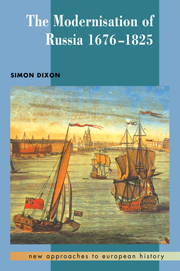1 - Modernisation theory and Russian history
Published online by Cambridge University Press: 05 June 2012
Summary
Modernisation theory
Loosely conceived, ‘modernisation’ may signify nothing more than a programme of reform required to bring an allegedly outmoded institution ‘up to date’ and fit to face the future. In Britain, for example, both the Labour Party and the Anglican church have recently been subjected to such campaigns, the one with more obvious benefit than the other. Modernisation, in this simple sense, has long appealed to historians as shorthand for the ways in which an apparently isolated and backward Muscovy – transformed into the Russian empire when Peter the Great (1672–1725) assumed the title ‘Imperator’ at the thanksgiving service for the end of the Great Northern War on 22 October 1721 – adopted Western standards in the eighteenth century in order to compete in the cut-throat world of the European international system. Scholars, however, have given modernisation explicit conceptual content, and it is in this sense, not always synonymous with Westernisation and sometimes directly contrary to it, that the term will be used in this book.
Modernisation theory takes as its principal economic transformation the shift from a network of predominantly rural communities, preoccupied by the needs of agrarian self-subsistence, to an increasingly urbanised, market-oriented society dominated by mechanised industry.
- Type
- Chapter
- Information
- The Modernisation of Russia, 1676–1825 , pp. 1 - 26Publisher: Cambridge University PressPrint publication year: 1999



